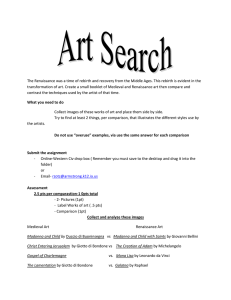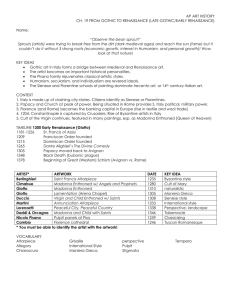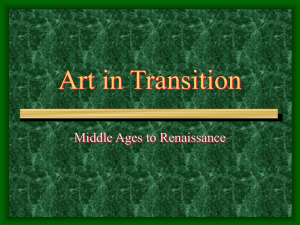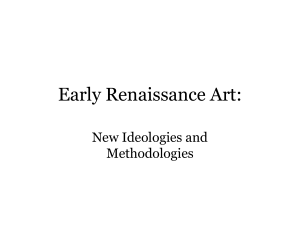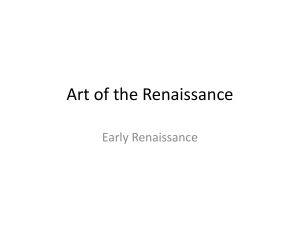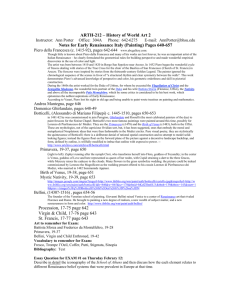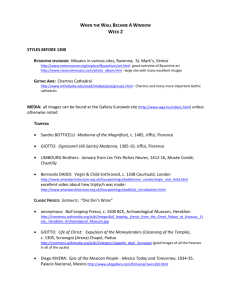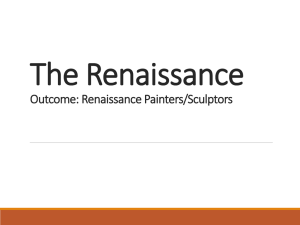Renaissance art lecture
advertisement
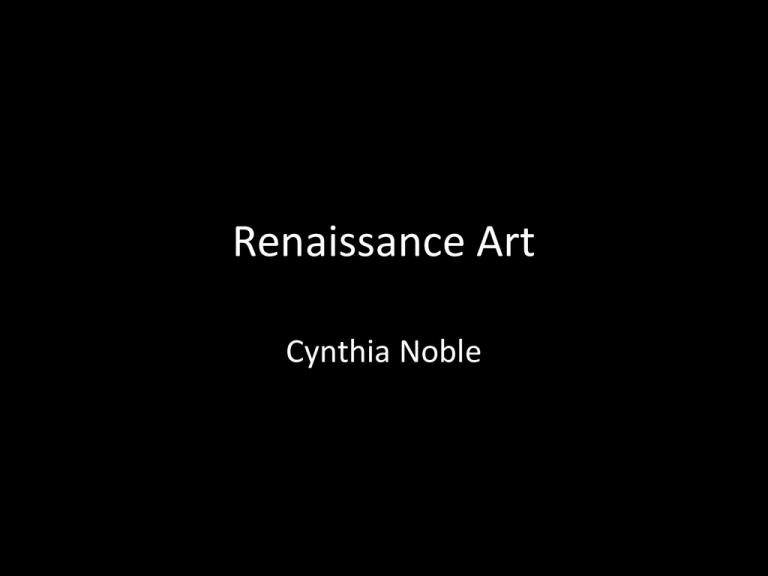
Renaissance Art Cynthia Noble Key Concept #1 • Classicism and Christianity: Renaissance means “rebirth,” a term applied by those living in Italy in the 15th century. It refers to the revival of classical learning within the framework of Christianity. The juxtaposition produces a creative tension. Key Concept #2 • Growing secularism engenders naturalism in art: The Renaissance culture encompassed a more secular point of view in contrast with the Middle Ages. This more humanistic worldview led to more convincing represenations of figures and the natural environment (naturalism) through the study of anatomy and the development of mathematical perspective. Key Concept #3 • Rise of the individual: Based on the humanistic ideals and also due to changes in the economy, individuals are recognized for their achievements. Patronage, which now extends beyond the Church to aristocratic families, is conferred upon invidual artists who began to compete for commssions and also enjoyed greater social status. Also, portraiture emerges as a painting genre because of the increased interest in creating representations of individuals. Assignment How do the two images express the historic changes that marked the transition from the Middle Ages to the Early Renaissance? (3-4 pages) Cimabaue. Virgin and Child Enthroned, c. 1820 (left) Giotto di Bondone. Virgin and Child Enthroned, c. 1305-10 (right) Note: Please refer to “Questions to Ask. . .” in this lecture to assist your writing. I QUESTIONS TO ASK WHEN WRITING ABOUT ART (adapted from Sayre, Writing About Art and D’Alleva, Look!) I. STATE THE VISUAL FACTS: Describe the image by considering the formal (visual) elements of the work and how they relate to its subject matter. How is line employed in the work? Does it seem to regulate or order the composition? Is it consistent with traditional laws of perspective or does it violate them? (i.e. Does the work convey a sense of three-dimensional space? Do the figures/objects in the image convey a sense of substantial form (mass), as if it had weight or volume. Are the figures/objects naturalistic or abstract (or somewhere in between)? What is the relation of shape to space in the work? How do light and dark function in the work? Is there a great deal of tonal contrast or is it held to a minimum? What is the predominant color scheme of the work? Are complementary or analogous colors employed? What other elements seems important? Is your attention drawn to the work’s texture? Does time seem an important factor in your experience of the work? How are these elements organized? Is there significant use of visual rhythm and repetition of elements? Is the composition balanced? Symetrically? Asymmetrically? Do various elements seem proportional, and how does the question of scale affect your perception? Does the composition seem unified or not? II. INTERPRETATION: What does all this mean? (Visual facts become supporting evidence for explaining the meaning of an image within its historical context.) Is there a particular political, religious, economic and/or social context in which this work was created? What is the subject? Why would the artist, patron (an individual, an institution, or an individual acting on behalf of an institution) or viewer be interested in a depiction of this subject? What is the motivation for the creation of this work? *Was this a new or innovative subject and/or style? If so, what prompted the change? *What political/religious/social/economic messages are being conveyed through the subject matter or artistic style of this work? Who was able to see the work of art? Under what circumstances? What is the artist trying to say about the subject matter of the work? What feelings or attitudes does the composition seem to evoke, and what specific elements or design choices in the composition account for these feelings? *Key questions Renaissance Image List Simone Martini. Annunciation, centerpiece of alterpiece in Cathedral, Siena, Italy, 1333. Sandro Botticelli. Cestello Annunciation, 1489-90 Martini/Botticelli Botticelli. Birth of Venus, c. 1484-86 Giorgio Vasari. Temptation of St. Jerome, 1541-48 Michelangelo. David, 1501-04 Leonardo da Vinci. Vitruvian Man, c.1487 Brunelleschi. Exterior of Florence Cathedral, 1417-36 Diagram of Brunelleschi’s perspective experiment Perugino. Delivery of the Keys to Saint Peter, fresco in the Sistine Chapel, Rome, 1482 Raphael. School of Athens, 1510-11 Dürer. Self-Portrait, 1500 Dürer. Four Apostles, 1526 Cimabaue. Virgin and Child Enthroned, c. 1280 (left) Giotto di Bondone. Virgin and Child Enthroned, c. 1305-10 (right)
